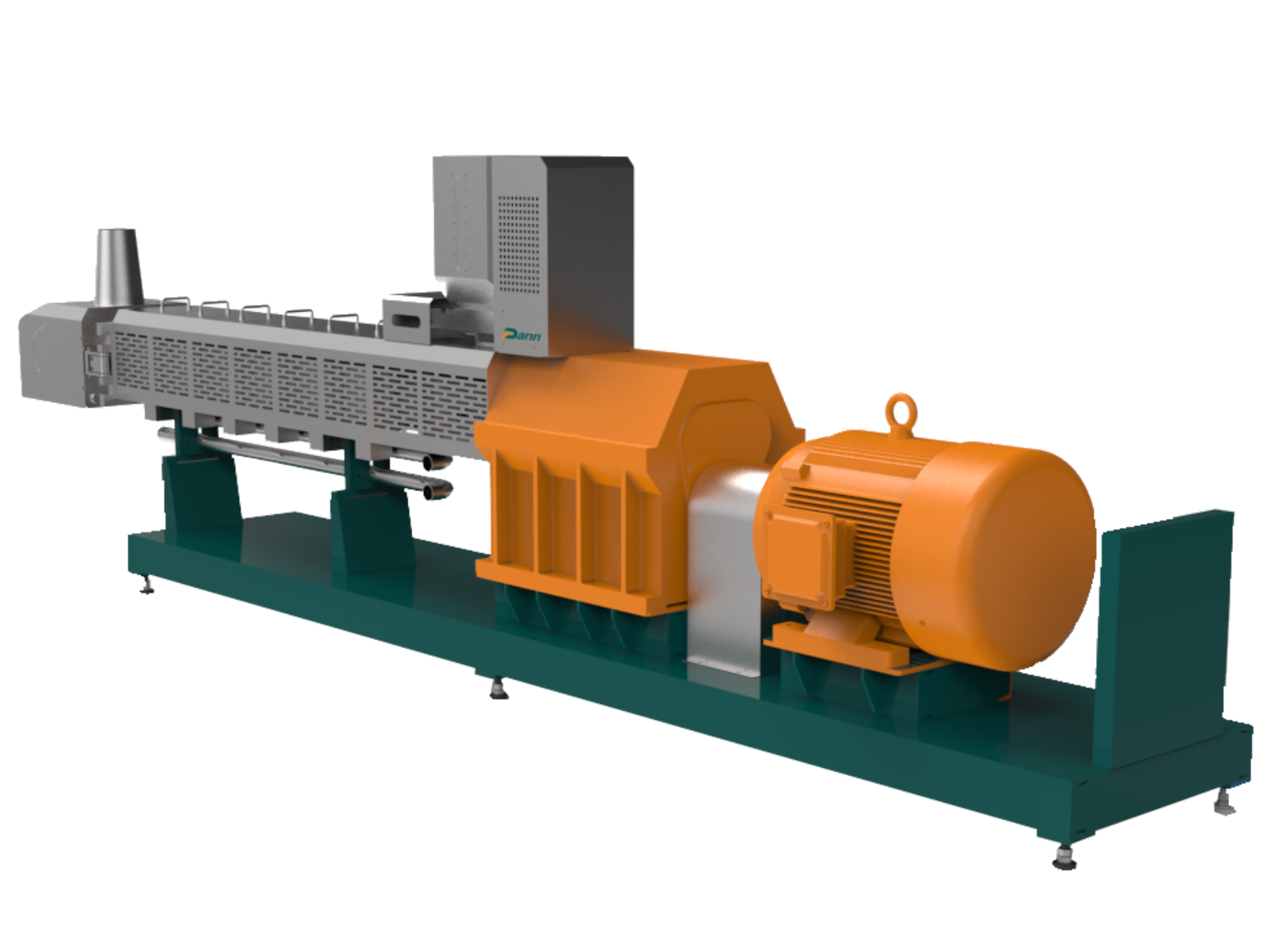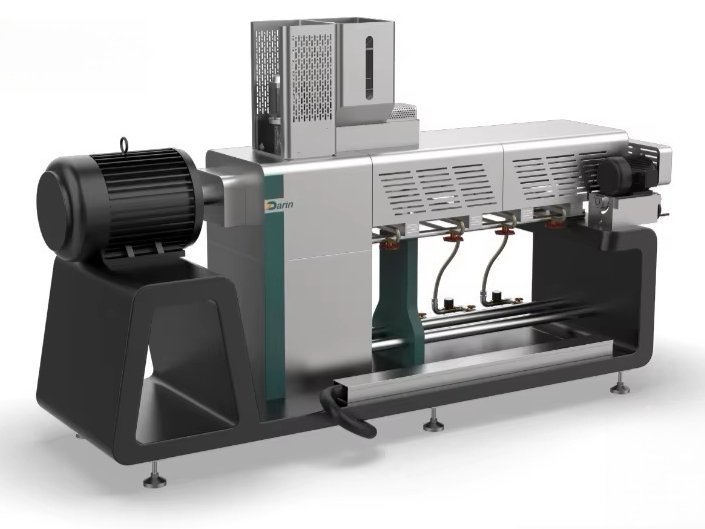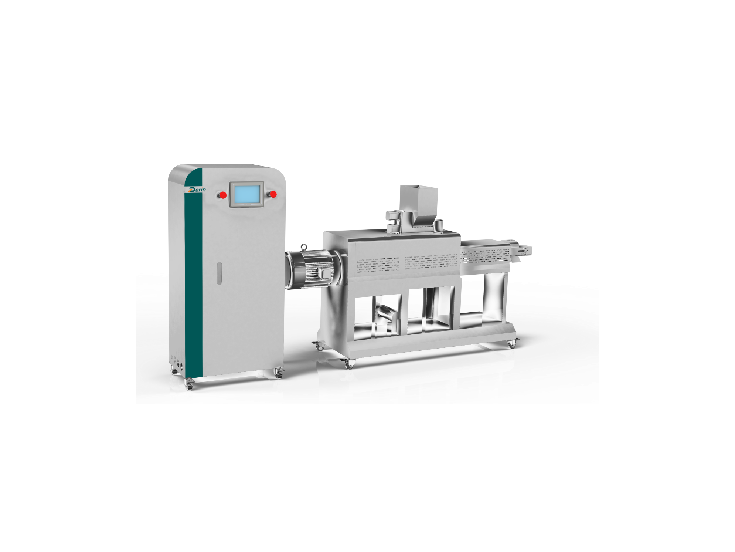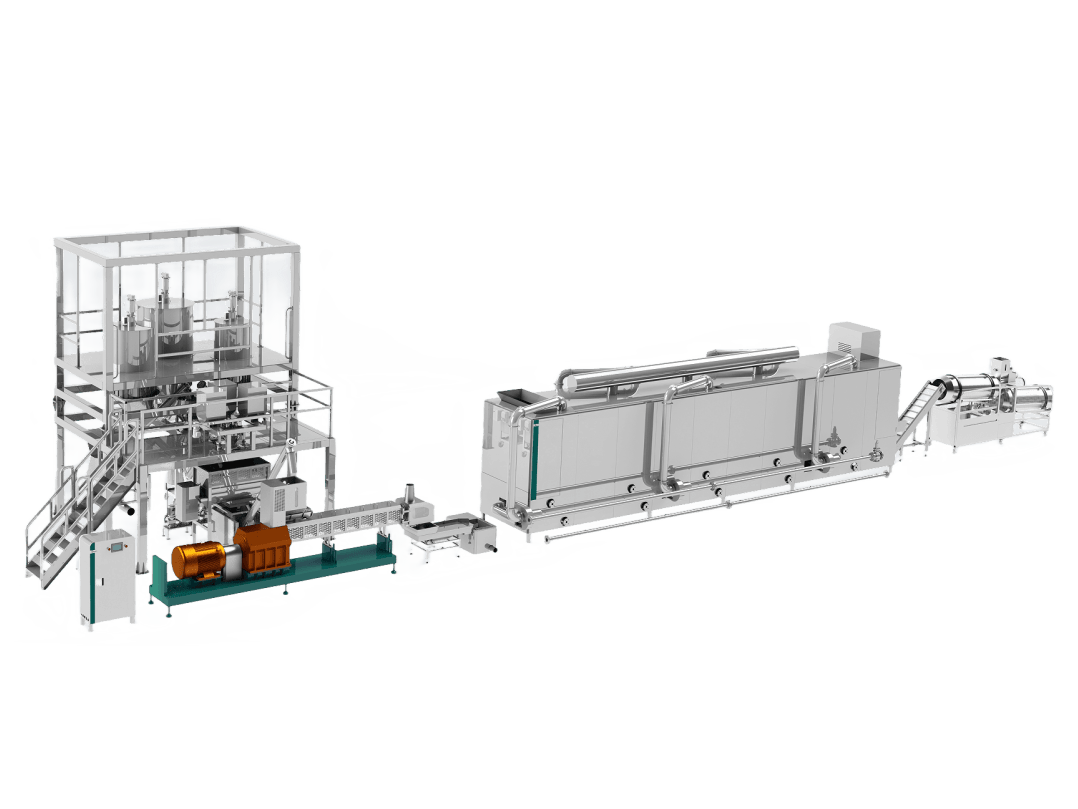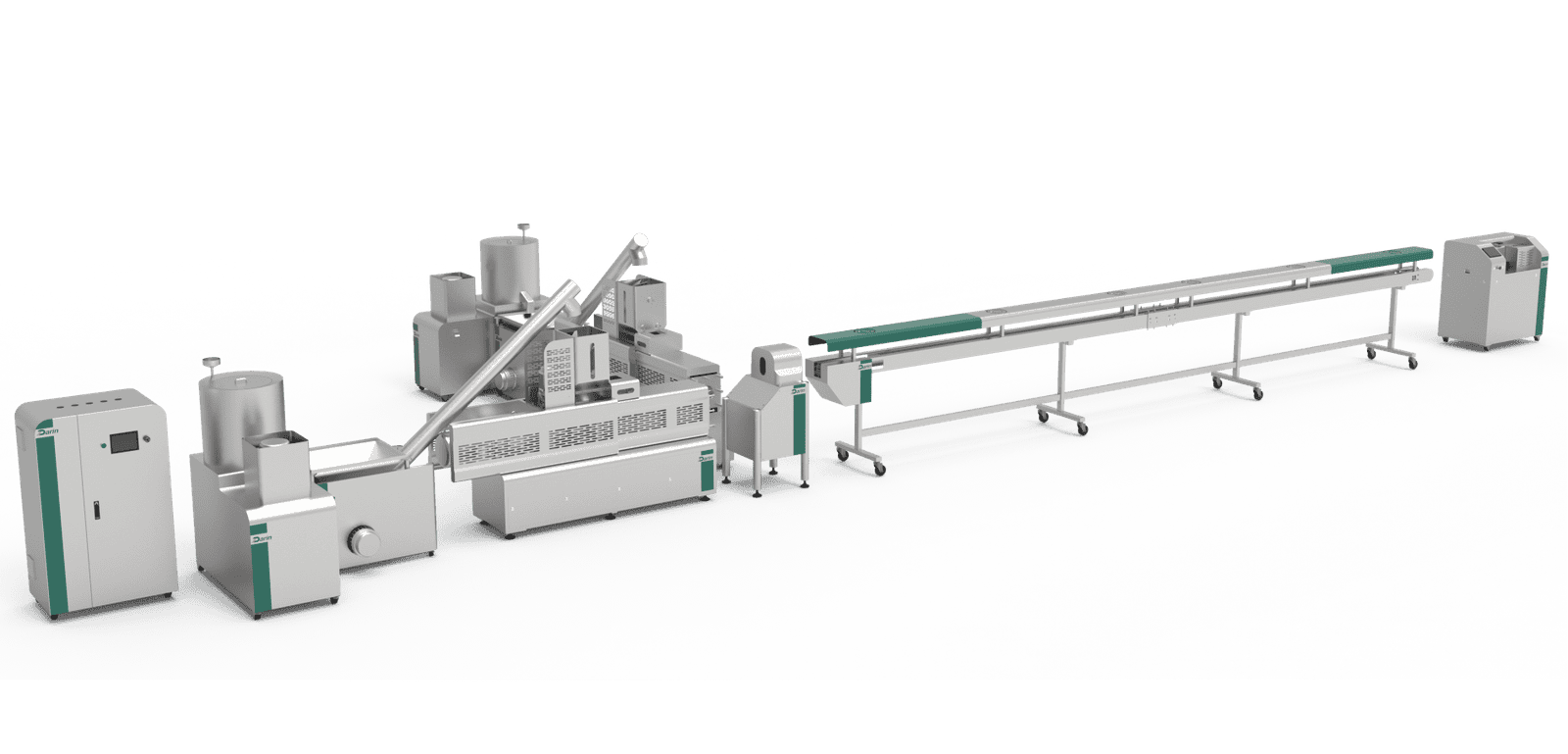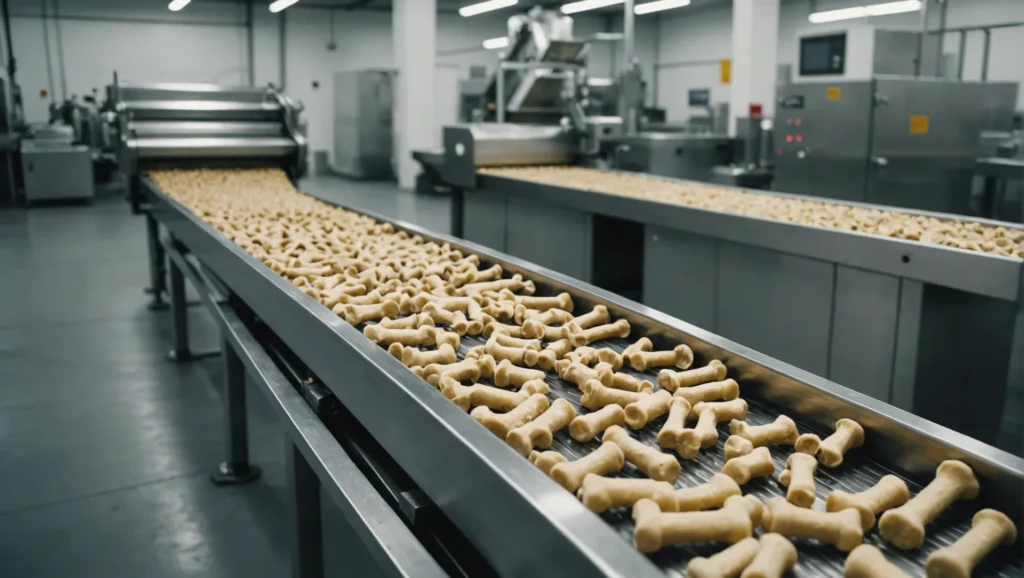
The demand for safe, nutritious, and long-lasting dog chews has grown tremendously with the global pet care market boom. However, many manufacturers or startups entering the pet treat industry often face the same challenge: understanding the complete dog chew production process — from raw materials to packaging. Without a clear grasp of the stages, production inefficiencies, texture inconsistencies, and quality control issues can arise. This article provides a comprehensive, step-by-step technical guide to the main stages in dog chew production, helping you optimize quality, efficiency, and cost with Darin Machinery’s professional line solutions.
The dog chew production process generally includes raw material preparation, mixing, extrusion or molding, shaping, drying, flavoring, sterilization, cooling, and packaging. Each stage plays a critical role in achieving the desired chew texture, durability, and palatability while meeting hygiene and safety standards.
If you’re planning to build or upgrade your dog chew factory, understanding each stage in depth can help you choose the right machinery, formulate better recipes, and ensure consistent product quality that meets market demand. Let’s go through each step in detail and see how modern technology — especially from Darin Machinery — optimizes every link in the chain.
Dog chews are made from natural bones.False
Most modern dog chews are made from starch, meat powder, gelatin, or rawhide alternatives rather than natural animal bones.
🏭 Stage 1: Raw Material Preparation
The foundation of any high-quality dog chew lies in its raw materials. Common ingredients include:
- Starch (corn, potato, tapioca)
- Gelatin or collagen
- Animal by-products (meat powder, chicken meal)
- Glycerin or sorbitol (for flexibility)
- Natural colors and flavors
Key Technical Steps:
- Ingredient weighing and proportioning: Based on recipe formulation, each ingredient must be measured precisely to maintain uniformity.
- Crushing and sieving: Larger particles are crushed and filtered to ensure even texture.
- Pre-conditioning: Moisture is adjusted to prepare the mix for extrusion or molding.
| Common Raw Material | Function in Dog Chew | Typical Ratio (%) |
|---|---|---|
| Starch (corn/potato) | Provides structure & binding | 40–60% |
| Gelatin/Collagen | Adds elasticity & chewiness | 10–20% |
| Glycerin | Softens texture | 5–10% |
| Flavoring & Colorants | Improves palatability | 1–3% |
Proper preparation ensures the next stages — particularly extrusion — operate smoothly without clogging or inconsistency.
⚙️ Stage 2: Mixing and Homogenization
Once materials are prepped, they’re transferred to a ribbon mixer or double-shaft mixer, where dry and wet ingredients combine into a uniform dough-like mass.
Technical Insights:
- Mixing time: 3–10 minutes depending on formulation
- Moisture content: Typically maintained around 20–25% before extrusion
- Temperature control: Critical to avoid premature gelatinization of starch
Modern automatic mixers feature PLC-controlled moisture dosing systems, ensuring reproducibility and reducing manual errors.
Overmixing dog chew dough can improve chew texture.False
Overmixing can break down starch granules and reduce elasticity, leading to brittle chews.
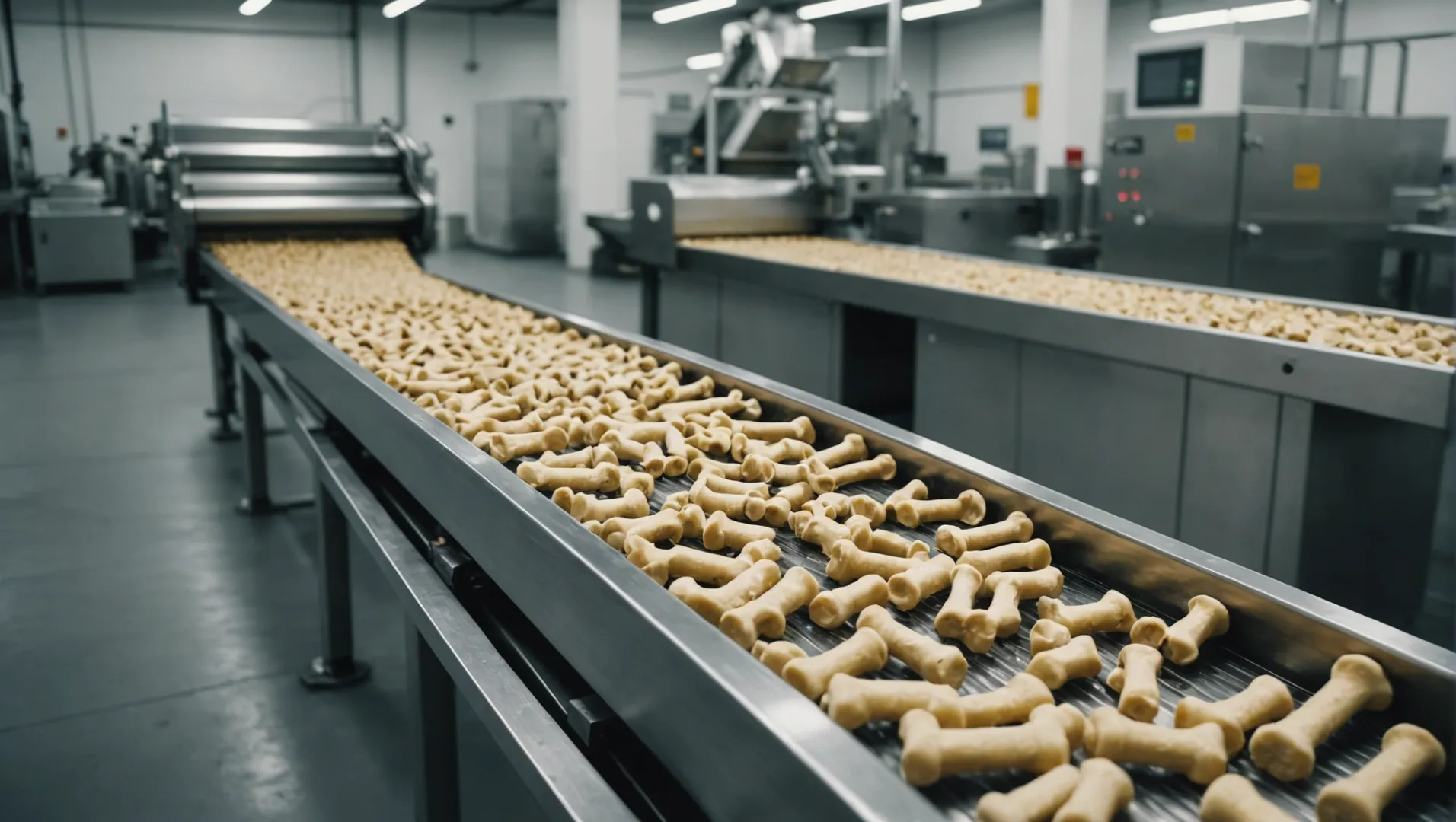
🔥 Stage 3: Extrusion or Molding
This is the core process in most modern dog chew production lines. Using a twin-screw extruder, ingredients are cooked, gelatinized, and formed under controlled temperature and pressure.
Step-by-Step Process:
- Feeding: The premixed material enters the extruder hopper.
- Cooking & Plasticizing: Twin screws knead and heat the dough at 100–160°C.
- Shaping: The semi-molten dough is forced through specially designed dies to form various shapes — sticks, bones, twists, rings, or stars.
- Cutting: Rotary or pneumatic cutters ensure consistent size and shape.
| Extrusion Parameter | Typical Range | Purpose |
|---|---|---|
| Barrel temperature | 100–160°C | Starch gelatinization |
| Screw speed | 200–500 rpm | Texture control |
| Pressure | 2–8 MPa | Densification & bonding |
| Moisture at exit | 15–20% | Pre-drying stage |
Darin’s advanced extruders allow quick die changeovers for versatile product shapes and feature automatic temperature and torque control to maintain consistent quality.
🦴 Stage 4: Shaping and Forming
For chews requiring complex forms — such as braided sticks or two-color bones — an additional forming or co-extrusion unit is used.
Common Techniques:
- Co-extrusion: For dual-color or dual-flavor products.
- Braiding machine: Automatically twists multiple extruded strands.
- Molding: Used for shaped chews like hearts, bones, or animal figures using hydraulic molds.
| Shaping Type | Typical Equipment | Example Product |
|---|---|---|
| Co-extrusion | Dual-screw extruder | Chicken-flavored core chew |
| Braiding | Automatic braider | Twisted stick chew |
| Molding | Hydraulic press | Heart-shaped treat |
This stage defines the visual appeal and chew resistance — both critical for market success.
🌬️ Stage 5: Drying and Dehydration
Drying determines the chew’s final moisture level and shelf life. Too much moisture leads to mold, while too little makes the chew brittle.
Technical Aspects:
- Drying method: Multi-layer continuous hot air dryer
- Temperature range: 60–100°C
- Drying time: 3–6 hours depending on thickness and size
- Final moisture content: 10–14%
| Drying Zone | Temperature (°C) | Time (min) |
|---|---|---|
| Zone 1 | 90 | 60 |
| Zone 2 | 80 | 90 |
| Zone 3 | 70 | 120 |
Darin dryers feature adjustable air flow and energy-efficient recirculation systems, reducing energy costs by up to 30%.
Dog chews should retain more than 25% moisture for softness.False
Ideal moisture is below 14% to ensure shelf stability and prevent microbial growth.
🍗 Stage 6: Flavoring and Coating
Once dried, chews are passed through a rotary flavoring drum. Oils, fats, or palatants are sprayed uniformly.
Key Benefits:
- Enhances taste and smell
- Prevents surface cracking
- Improves visual appeal with gloss or color finish
Automated spray systems ensure precise dosing, while excess oil is recovered to minimize waste.
🧫 Stage 7: Sterilization and Cooling
Sterilization ensures microbiological safety. Typically, UV sterilization or thermal treatment is used.
Steps:
- Sterilization: UV or ozone sterilizers destroy residual microbes.
- Cooling tunnel: Brings product temperature to ambient (25–30°C) before packaging.
Proper cooling is essential to prevent condensation inside the packaging, which could reduce shelf life.
📦 Stage 8: Packaging and Storage
The final stage ensures product freshness, branding, and convenience.
Common Packaging Options:
- Pillow-type bags (for single or small chews)
- Zip-lock bags (resealable for retail)
- Bulk cartons (for wholesalers)
| Packaging Type | Material | Application |
|---|---|---|
| Pillow bag | PET/PE film | Small chews |
| Stand-up pouch | Aluminum foil | Premium chews |
| Bulk carton | Corrugated | Export & wholesale |
Automated weighing, filling, and sealing systems integrated with coding machines improve accuracy and traceability.
Vacuum packaging is necessary for all dog chews.False
Vacuum packaging is used mainly for moist chews; dry chews use sealed bags with nitrogen flushing instead.
🌍 Stage 9: Quality Control and Inspection
Darin Machinery’s lines integrate real-time data monitoring and quality sensors. Testing includes:
- Moisture analysis
- Hardness testing
- Microbial checks
- Color uniformity
Statistical Process Control (SPC) ensures batch consistency and regulatory compliance (e.g., FDA, CE, ISO22000).
📈 Stage 10: Continuous Improvement & Customization
Modern pet treat plants evolve continuously:
- Adding co-extrusion modules for layered chews
- Integrating vacuum coating for higher palatability
- Implementing AI-based quality cameras for defect detection
Manufacturers can tailor texture, density, and nutritional profiles to different market segments — from puppy soft chews to durable dental chews.
Final Thoughts
Dog chew production is a highly engineered process that merges food science, automation, and pet nutrition. Each stage — from raw material preparation to final packaging — influences product performance, consumer satisfaction, and profitability. Darin Machinery offers fully automated, customizable production lines that ensure consistency, safety, and efficiency for all dog chew formats.
📞 Ready to Build Your Dog Chew Production Line?
Darin Machinery designs and manufactures complete dog chew production solutions — from single extruders to turnkey plants. Contact us for tailored equipment, plant design, and cost-effective solutions.
Website: www.petreatsmachine.com
Email: darin4@darin.cn
WhatsApp: +86 156 5000 7983
Darin Machinery — Professional Pet Food & Treat Processing Lines Manufacturer


